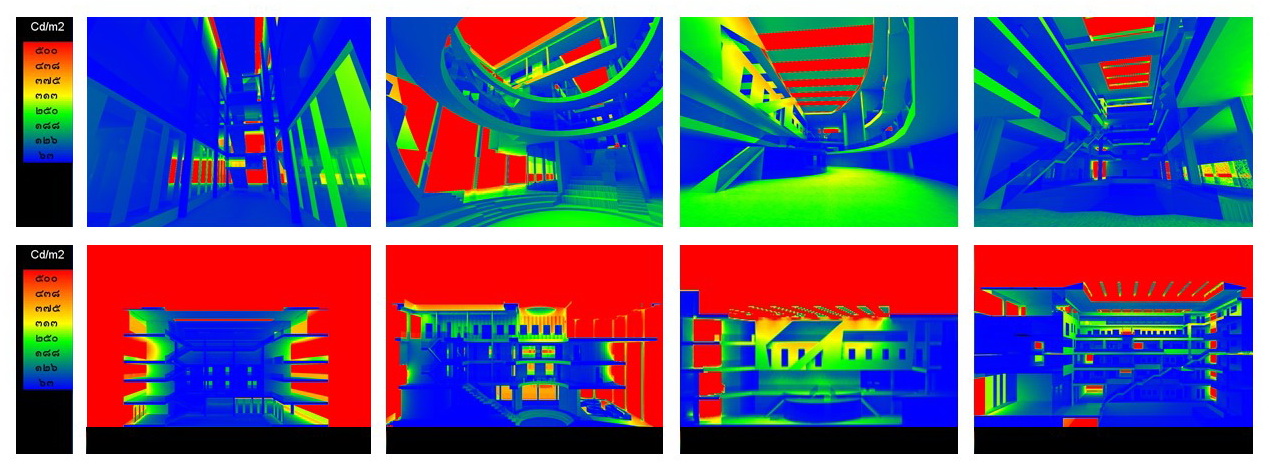Daylighting in Semi-open Atrium for Sustainability: Case Studies of Educational Buildings in Bangkok Suburbs
Main Article Content
Abstract
Since high-quality daylighting in the semi-open atriums in educational buildings could promote learning efficiency, well-being, and reducing the use of energy. Therefore, the study of appropriate daylighting in atriums is substantial for the design consideration of sustainable architecture.. The objective of this research was to find the relationships between the physical forms of the atriums which affect the daylight qualities in the atriums, to develop the knowledge of daylighting in sustainable buildings. The research started with analyzing of 4 case studies to know the dimensional proportion and characteristics of the case studies, such as openings, well indexes (WI), and the compositions of the atriums. Next, evaluating daylight performances inside the atriums by computer simulation. Then, comparing the results of the quantities and qualities of daylight inside the case studies. Lastly, discovering the relationship between physical characteristics and the results of daylight evaluation. The important indicators are; luminance (I), illuminance (E), uniformity of light (U), daylight factor (DF), useful daylight illumination (UDI), spatial daylight anatomy (sDA), annual sunlight exposure (ASE), and daylight glare probability (DGP). The results found that; 1) The proportional area of the skylight affects daylight in the atrium most. 2) The wall openings at the floor level help control the uniformity of light in the atrium. 3) The well index value affects directly the illuminance in the atrium. 4) Shadings of the above balcony, blind areas in the atrium, and light reflection from building surfaces affect the illuminance on the working plane and the uniformity of light in the atrium. 5) Daylight exceeded 3000 lux could course glare. 6) The evaluation of daylight in the vertical plane and the annual daylight simulation with climate-based daylight modeling (CBDM) helps to visualize more realistic perceptions. Therefore, the design of daylighting in semi-open atriums should consider; 1) the effects of sunlight radiation in the atriums 2) the amount of daylighting concerning the proportion of the atriums, 3) the daylighting qualities that do not cause glare effect, 4) the internal facade compositions that promote daylight distribution, and 5) the arrangement of interior space due to daylight effects.
Downloads
Article Details

This work is licensed under a Creative Commons Attribution-NonCommercial-NoDerivatives 4.0 International License.
All material is licensed under the terms of the Creative Commons Attribution 4.0 International (CC-BY-NC-ND 4.0) License, unless otherwise stated. As such, authors are free to share, copy, and redistribute the material in any medium or format. The authors must give appropriate credit, provide a link to the license, and indicate if changes were made. The authors may do so in any reasonable manner, but not in any way that suggests the licensor endorses you or your use. The authors may not use the material for commercial purposes. If the authors remix, transform, or build upon the material, they may not distribute the modified material, unless permission is obtained from JARS. Final, accepted versions of the paper may be posted on third party repositories, provided appropriate acknowledgement to the original source is clearly noted.
References
Ahmad, M., & Rasdi, M. (2000). Design Principles of Atrium Building for the Tropics. UTM: Malaysia.
Binggeli, C., & Greichen, P. (2011). Interior Graphic Standards (2nd Ed.). New Jersey: John Wiley & Sons.
Illuminating Engineering Association of Thailand, TIEA. (2018). Guidelines for Indoor Lighting Design. Retrieved May 1, 2019 from http://www.tieathai.org/images/intro_1479229183/final.Guidelines_BW.pdf
International WELL Building Institute, IWBI. (2019). Daylight Modeling. Retrieve May 4, 2020 from https://standard.wellcertified.com/light/daylight-modeling
Karlsen, L., Heiselberg, P., & Bryn, I. (2014). Implementation of daylight as part of the integrated design of Commercial Buildings. Retrieved May 1, 2020 from https://gbce.es/archivos/ckfinderfiles/WSB14/Conclusions_2.pdf
Kim, G., & Kim, J. (2010). Luminous impact of balcony floor at atrium spaces with different well geometries. Retrieved May 9, 2020 from https://doi.org/10.1016/j.buildenv.2009.08.014
LightStanza. (2020). Understand the Complexities of Daylight Analysis. Retrieved January 22, 2020 from http://lightstanza.com/daylight-reference-guide/
Mardaljevic, J., & Brembilla, E. (2017). Climate-Based Daylight Modelling. Retrieved May 1, 2020 from http://climate-based-daylighting.com/doku.php?id=academic:climate-based-daylight-modelling
Ministry of Energy. (2011). Thailand 20-Year Energy Efficiency Development Plan (2011-2030). Retrieved January 22, 2020 from http://www.eppo.go.th/images/POLICY/ENG/EEDP_Eng.pdf.
Navvab, M. (2011). Plant Lighting Aspects for Plant Growth in Controlled Environments. Conference: CIE 27th Session, Sun city, South Africa, 2, 246-256.
Net zero energy buildings, NZEB. (2018). Net zero energy buildings: Daylighting. Retrieved January 15, 2020 from http://www.nzeb.in/knowledge-centre/passive-design/daylighting/
Parans. (2017). Daylight – Increase the Productivity by 18%. Retrieve January 16, 2020 from https://www.parans.com/daylight-increase-the-productivity-by-18/
Phillips, D. (2004). Daylighting: Natural Light in Architecture. Boston: Elsevier.
Tasit, P. (2017). Energy Management in Academic Building Case Study of Social Science Building at Thammasat University Rangsit Campus. Thesis for Master Degree of Science Program in Energy Technology and Management. Bangkok: Chulalongkorn University.
Tregenza, P., & Wilson, M. (2013). Daylighting: Architecture and Lighting Design. New York: Routledge.
U.S. Green Building Council, USGBC. (2020). Leed v4 BD+C guilde: Building Design and Construction. Retrieved May 4, 2020 from https://www.usgbc.org/leed/v41#0
VELUX. (2014). Daylight, Energy and Indoor Climate Basic Book. Retrieved January 22, 2020 from http://www.velux.com/~/media/com/articles/pdf/deic_basic_book_ver%203-0.pdf
Wikiwand. (2020). Daylighting. Retrieved May 9, 2020 from https://www.wikiwand.com/en/Daylighting.
Zhao, W., Kang, J., & Jin, H. (2015). Architectural Factors Influenced on Physical Environment in Atrium. Renewable Energy in the Service of Mankind, 1, World Renewable Energy Congress (WREC).


